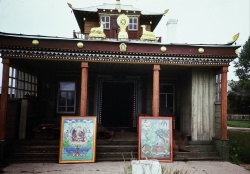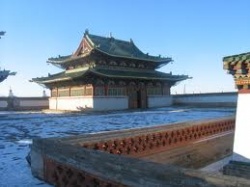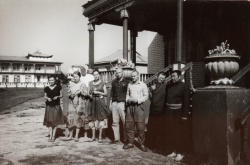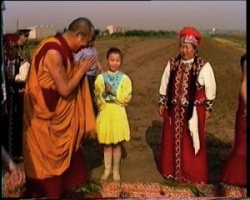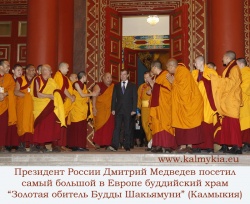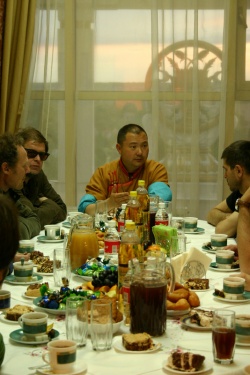The Buddhist revival in Russia (late 1980s 1990s) and Tibet by Alexander I. Andreyev
Historically, Buddhism, of the kind that was widely practiced in Mongolia and Tibet under the denomination of Gelugpa, took root in the two borderland areas of Russia: Kalmykia, on the lower Volga and Don, and Buryatia (Transbaikalia), after these territories had been finally incorporated into the Russian Empire in the early XVIII-th century. Two and a half centuries later, in 1944, one more Buddhist country, that of Tuva, had become a part of Russia (USSR). Situated in south Siberia and contiguous with Mongolia, Tuva, since 1914, had been under Russian protectorate, and was known then as Urianhaisky Krai. These three entities enjoy nowadays the status of autonomous republics within the Russian Federation.
Despite the oppressive national and religious policies of Tsarist Russia, the Kalmyks, Buryats and Tuvians performed their Buddhist rites quite freely in the XVIII – early XX-th centuries. The situation radically changed after the revolution in Russia: by the end of 1930s, in two post-revolutionary decades only, Buddhism was completely wiped out from the country, as a result of the ruthless crackdown on religion by the Soviets. All monasteries in Buryatia and Kalmykia were closed, and a large number of the clergy found themselves in the labor camps in the Gulag. The total number of the persecuted Buddhist clergy is still unknown to us. It is beyond doubt however that most of the senior monks fell victim to the terror of 1937-38, branded as counter-revolutionaries, kolkhoz wreckers, pan-Mongolists or Japanese agents. According to the KGB records, in the period between January 1, 1937, and November 1, 1938, 1864 Buddhist clergymen were arrested in Buryatia alone, of whom 969 were convicted.
The old-timers still recall how one frosty winter night, in 1937, a group of 50 Buryat lamas was shot in the steppe, outside the railway junction of Tahoi, a short distance from the Gusinoozersky datsan, the residence of the head of the Buryat Buddhisty community, the Bandida Khambo-Lama. The three most outstanding leaders of Soviet Buddhists in 1920-30s, Danja Munkujapov, Sherap Tepkin and Agwan Dorjiev, also shared the fate of thousands of their coreligionists.
Between 1937-1946 all Buddhist practices in Buryatia were suppressed by which time most of the datsan buildings had disappeared from their site without a trace. The same reprisals hit the Kalmyk Buddhists in the late 1930s. And then, in 1943, the Kalmyk autonomy was liquidated and its entire population was forcedly deported to north Siberia, allegedly for collaboration with the Nazis, who had occupied the Northern Caucasus a year before. It was only in 1957, following Joseph Stalin’s death, that Moscow re-established the Kalmyk Autonomous Region and allowed the deportees to return to their homeland. Nonetheless, Buddhism had remained practically non-existent in Soviet Kalmykia for several decades therefter.
The Buryats, on the other hand, had a far better luck: shortly after the world war II Stalin, whose personal attitude to religion had become more tolerable by then, allowed a host of Buryat lamas, those who survived the purges of the 1930s, to resume the performance of Buddhist rites though on a very limited scale, under the strict control of the state officials and, of course, under the all-pervading KGB surveillance. Consequently, two monasteries were open for Buryat Buddhists: the old Aga datsan in the Agynsky Buryat autonomous district (within the Chita Region) and a newly built one, the Ivolga datsan, outside Ulan-Ude, which would become the new residence of the Bandida Khambo-Lama. The Buddhist sangha, or order, in Buryatia (Buryat Autonomous Soviet Socialist Republic) was officially reinstituted in May 1946 on the initiative of a group of senior monks and laymen headed by two former members of the Central Spiritual Board, lamas H. Galsanov and L.N. Darmaev. The same assembly also adopted the new regulations for the Buddhist clergy in the USSR, and elected the Buddhist Central Religious Board (Tsentralnoe Dukhovnoe Upravlenie Buddistov, TsDUB SSSR), much along the line of the Central Spiritual Board that had existed in the 1920s-1930s in the wake of the Buddhist reformation movement in the country headed by the already mentioned lamas Munkujapov, Dorjiev and Tepkin. Like its predecessor, the body found itself all too soon in the firm grip of the state, and was used as a convenient tool for Soviet propaganda abroad. In the 1960s – early 1980s, in the atmosphere of the Cold War, Moscow strongly encouraged the leading Buddhists to participate in the international peace movement, as a way of frustrating the evil designs of world imperialists. Also, since 1956, the Buddhist Central Board of the USSR has affiliated with the World Buddhist Fellowship (WBF), and the well-known Soviet Buddhologist, Prof. S.D. Dylykov (a distant relative of Agwan Dorjiev) acted as a Vice-President of this organization. Henceforward representatives of Soviet Buddhists would be taking part in all WBF conferences, beginning with the fourth held in Kathmandu.
It was in June 1979 that HH the Dalai Lama visited the USSR for the first time (and he was in fact the first Dalai Lama to come to the country). This occurred at a time when the Chinese authorities accepted his proposal to send a fact-finding mission to Tibet, being an attempt to find a peaceful solution to the Tibetan question. The visit was not an official one, as the Dalai Lama was actually transiting the Soviet territory on the way to Mongolia, however the Soviet authorities allowed him to make two brief stopovers – in Moscow and Ulan-Ude. In his memoirs “Freedom in Exile” HH recalled that upon arrival in Moscow “I felt as if I was back in the familiar world. I recognized at once the same repressive atmosphere that I had come to know so well in China”. From Moscow he journeyed to Ulan-Ude, the capital of the Buryat Republic, where he spent a day in the Ivolga monastery (Ivolginsky datsan). “Although I was unable to communicate directly with anyone, I found I could understand their prayers as these were said in Tibetan … The monks also wrote in Tibetan. On top of this, I discovered that we could converse very well with our eyes. As I entered the monastery, I noticed that many of the monks and lay people in the congregation were in tears. This was just the sort of spontaneous expression that Tibetans are prone to and I felt immediate kinship”.
The Dalai Lama visited the Soviet Union again in 1982, this time at the invitation of the Buddhist Central Board. And again he traveled to Buryatia to meet with his co-religionists there. The importance of these first two visits by the head of the Tibetan Buddhist Church can hardly be overestimated as they stirred up this quiet placid country and gave a certain impetus to the revival of Buddhism in Buryatia, no matter if only a few hundred people were able to meet with the Dalai Lama and listen to his sermons. On a larger scale, this also seemed to be a revival of religious and cultural links between Russia and Tibet that had once existed. Thus in 1981 the secretary of the Department of Religion & Culture of the Central Tibetan Administration of HH the Dalai Lama at Dharamsala, Venerable Khamtrul Rinpoche, came to Moscow where he signed an agreement with the Central Buddhist Board providing for education of Tibetan students in the USSR. As a result three young Tibetans were sent by the Dalai Lama to the Soviet Union in the same 1982: two of them, Ngawang Rabgyal and Ngawang Gelek, were then enrolled in Kiev State University to study international relations and international law accordingly, and the third one, Tashi, was admitted to Simferopol State University in the Crimea to study world history, from the socialist point of view. According to Tashi, “there was no particular political motive behind sending the students to the Soviet Union, since the Central Tibetan Administration sends Tibetan students to many countries including the United States as well as Europe and Asia for studies”. Yet, I believe that the Dalai Lama’s visits and the above agreement had a certain political dimension, considering the uneasy relations between Beijin and Moscow at that time. It is difficult to imagine that Khamtrul Rinpoche could come to Moscow and sign an agreement with the Buddhist Central Religious Board without the knowledge (and consent) of the Ministry of Education and the Foreign Ministry, to say nothing of the Soviet Government and the all-powerful Politburo. Getting ahead of the story, I would like to note that after the collapse of the USSR these three Tibetans would be appointed by Dharamsala as representatives of HH the Dalai Lama to Russia, CIS and Mongolia.
These early contacts of the Dalai Lama with Moscow must have urged the Soviet leaders on a rather intricate and far-fetched intrigue, so it seems. On April 30, 1980, L.V. Scherbakov, information director of the Soviet Council for Religious Affairs, declared at a press conference in Delhi that the Soviet Union was “always willing to help any nation struggling for independence and justice”. The statement was made in response to a newsman’s query regarding the Tibetan issue. Scherbakov, however, made it clear that the Moscow “had never received any appeal for help from Tibetan Buddhists”. Two years later, in August 1982, a Tibetan official, Pema Gyalpo, who had accompanied the Dalai Lama on his tour of the East Asian countries, revealed in Singapore that the Soviets offered Tibetans some support, including military assistance [sic], for achievement of their right of self-determination. The Indian daily Hindustan Times which brought out this sensational news continued by saying that the Soviet offer of support and assistance, evidently the first of its kind to have been made to the Dalai Lama by Moscow, “appears to imply that the Soviet Union does not recognize Tibet as a part of China, the corollary being that Moscow now considers China’s presence in Tibet as illegal and as synonymous with military occupation”.
This implication, however, was wrong: the Soviet leaders had never really questioned the legitimacy of China’s annexation of Tibet, though they indeed subjected their neighbor, in the period of Sino-Soviet confrontation, to a most severe criticism for its national policy with regard to the non-Han peoples of China, including Tibetans. The essence of this policy was described then as “forcible assimilation and Sinification” of national minorities, being a gross violation of the Marxist-Leninist teachings. Interestingly, this criticism was articulated not by any particular Soviet leader but mainly through the media of Soviet Oriental scholars (those from the prestigious academic Institute of the Far East) and their colleagues from other socialist countries (such as Mangolia and Vietnam). The Soviets had never gone any further than that as their true purpose was to restore the former brotherly relations with the Chinese communists, who were supposedly led astray from the socialist path by Mao and his followers in the CCP new leadership. Therefore I strongly doubt that Moscow could consider in earnest, in the early 1980s, a possibility of offering support to the Tibetan opposition in Dharamsala, to say nothing of giving them military assistance. It all looked like a well-designed bluff on the Soviet part with a view towards bringing about a much-coveted detent with Beijin, at this final stage of the Cold War. The Kremlin was seriously alarmed by Chinese military presence in Tibet – a continuous growth of the number of troops deployed, but, more importantly, by the recently installed long-range nuclear missiles on the plateau. Yet, the Chinese leaders also had reasons to talk about “Soviet expansionism” in Central Asia, seeing that the Russians had in effect removed the buffer between the Pakistan-occupied Kashmir and Soviet territory by deploying their troops in the strategic “Wahan corridor” in Afghanistan.
The genuine detent between the Soviet Union and the West, however, became possible only after M. Gorbachov had started his perestroika in the mid-1980s. The latter, as is known, led to a radical improvement in Sino-Soviet relations and also to a religious and cultural revival in the USSR in the late 1980s. The Dalai Lama who paid another visit to Russia in 1986 had a chance to feel these fresh “winds of changes” in the country. The things he had personally witnessed impressed him very much, but he was likewise pleased to hear about the radical changes taking place in China, after Deng Xiaoping had started his modernization of the country.
Towards the end of the decade, as the religious revival was gaining momentum, more Tibetans would come to Russia. Thus in 1989-1990 some senior Tibetan lamas, including the Venerable Bakula Rinpoche and the state oracle of Tibet, visited Leningrad (today’s St Petersburg) to perform the purification rites in the old Buddhist temple there, which had been transferred to the custody of a recently emerged religious group, the Leningrad Buddhist Society. This group which came into existence spontaneously in the hey-day of perestroika and consisted of both European and traditional Asian Buddhists (mainly Buryats) was officially registered by the Council of Religious Affairs in Moscow. More similar groups would appear in both European and Asiatic Russia in the following years. About the same time a process of restoration of the old Buddhist temples and construction of new ones began in the three Buddhist areas of Russia, primarily in Buryatia.
This powerful Buddhist revival movement continued well into the 1990s despite the collapse of the USSR. Consequently, by mid-1995, there were already 17 active datsans (temples) opened to the believers in Buryatia and the Agynsky Buryat autonomous district and three more were under construction, most of them on their original sites. These Buryat datsans formed a religious organization called “The traditional Buddhist Sangha of Russia” under the head of the Buryat Buddhist Church, the Bandida Khamba-Lama. In Kalmykia one khurul (temple) in Elista and 15 more Buddhist communities in Elista and elsewhere in the republic were set up. All of these comprised the Union of Kalmyk Buddhists, headed by Venerable Telo Rinpoche, the Shajin Lama (or Grand Lama) of the Kalmyk People. This monk was recognized by the Dalai Lama as an incarnation of the renowned Indian yogin Tilopa, the founder of the Kagyu school. In Tuva (Tyva) one temple, or khure, Tuvdan Choikhorling, was built in its capital Kyzyl, and ten Buddhist groups, or “societies”, were officially registered, all under the administration of the Kamba-Lama of Tuva, as well as one Dharma center. At the same time dozens of Buddhist groups of various denomination and size emerged in many Russian cities. These consisted mainly of young Europeans, practicing Tibetan Buddhism as well as Buddhism of other Asian countries (Korea, Vietnam, Japan, India). One particular feature of this Buddhist revival was that the new Russian Buddhists were socially active and well integrated into the modern many-faceted urban culture.
Part 2
The revival of Buddhism, which began in Russia in the hay-day of Gorbachov’s perestroika, is closely linked with two important factors: the overall democratization of the country which drastically changed the political and cultural atmosphere in the Soviet Union and, consequently, the re-establishment of religious and cultural relations between the Buddhist communities in Russia and the Tibetan lamas as well as HH the Dalai Lamae head of the Tibetan Buddhist Church.
I would like to emphasize, right from the outset, the paramount importance of restoration of the age-old religious and cultural ties between the Russian and Tibetan Buddhists as this actually meant the restoration of the former Russian-Tibetan relations, albeit Tibet in that case was represented by the Tibetan refugee community in India and the Dalai Lama’s government-in-exile at Dharamsala. The key role in the Buddhist revival was played by the Dalai Lama who became a regular visitor in Russia in the early half of 1990s.
By the time when M. Gorbachov had launched his sweeping reforms, there were only two active Buddhist temples, or datsans, in the country, the Ivolga datsan outside Ulan Ude and the Aga datsan in the Byryat Agynsky Autonomous area, a part of the Chita Region. The Ivolga datsan, built in 1946, was the residence of the Bandida Khambo-lama, the head of the Buryat Buddhist community and the Soviet Buddhist Sangha in general. It was only in these two places that the Russian Buddhists were allowed to practice their religion, according to the Soviet legislation. The Dalai Lama’s earliest visits to the USSR were in 1979 and 1982, when he actually transited the country on his way to Mongolia and had just enough time for two brief stopovers in Moscow and Ulan Ude. On both occasions he visited the Ivolga datsan and his comings there were in fact most thrilling shake-ups for the Buryat believers. The third time he visited the USSR was in 1986, under Gorbachov, and he could already witness then the incipient changes for the better taking place in the country.
The real break-through came about only at the end of the decade. As the religious revival was gaining momentum, more Tibetans would be coming to Russia. Thus in 1989-1990 some senior Tibetan lamas, including the Venerable Bakula Rinpoche and the state oracle of Tibet, visited Leningrad to perform the purification rites in the old Buddhist temple there, which had been transferred to the custody of a recently emerged religious group, the Leningrad Buddhist Society. This group consisted of both European and traditional Asian Buddhists (mainly Buryats) and it was officially registered by the Council of Religious Affairs in Moscow. More similar groups would appear in both European and Asiatic Russia in the following years. About the same time a process of restoration of the old Buddhist temples and construction of new ones began in the three Buddhist areas of Russia, primarily in Buryatia.
The major problems that the revival movement faced from the outset (and is still facing) was the paucity of funds for the construction of new temples/monasteries (datsans, khuruls, and khures) and the shortage of Buddhist teachers and fully ordained monks (lamas), without whom the correct performance of rites was impossible. In Buryatia alone there was no more than 40 lamas in 1991, serving in the two principal datsans in Aga and Ivolga.8 The problem of Buddhist education was by far the biggest one and it obviously could not be tackled overnight. Another serious problem was absence of Buddhist literature and religious items. This made it necessary for Russian Buddhists (we can neglect for the time being the dogmatic and ritual differences in the practice of Tibetan Buddhism by Buryats, Kalmyks, and Tuvians) to turn for help to the Tibetans, primarily the Dalai Lama. And the assistance was soon forthcoming.
Since 1991 the Dalai Lama has become a regular visitor in Russia. He quickly re-established contacts with the traditional Buddhist communities in Buryatia, Kalmykia, and Tuva and reacted very positively to their appeals for help. As a result in the early 1990s a series of agreements was signed between the regional governments acting on behalf of these entities and the Dalai Lama’s administration which provided for two essential things:
1) sending of Tibetan teachers (lamas) as well as Buddhist literature, ritual objects and attributes to them as a means of reviving Buddhism in these three areas of Russia, and
2) arranging for the Buddhist education of young Buryats, Kalmyks and Tuvians in India (mainly in the Tibetan monastic schools in the state of Karnataka and in Dharamsala). These provisions, being of paramount importance, were enthusiastically hailed by Russian Buddhists who sought closer links with the Tibetan Buddhist Church and the Dalai Lama in particular. During his visits to Buryiatia, Kalmykia and Tuva, where Buddhism once thrived, especially in 1991-1992, the Tibetan leader was given a most hearty and emotional welcome, as happened, for example, in Tuva in 1992, when thousands of people lined up the road from the airport in Kyzyl to the city center, many of them standing on the knees, with tears in their eyes, greeting him as the Living God. All his movements, appearances in public and statements were given a detailed coverage in the local press.
When talking about the Buddhist revival in Russia I would like to emphasize the fact that it was mainly Kalmykia that established especially close relations with the Dalai Lama and his administration in Dharamsala. This became possible due to persistent and most energetic endeavors of the young Kalmyk president, Kirsan Iliumjinov, who strove to revive Buddhism in his country, but also to forge a direct link between the Kalmyk government and the Dalai Lama, which had existed in the XVII and XVIII centuries. At the end of 1992 Dharamsala was visited by an official Kalmyk delegation, headed by the first deputy of the Chairman of the Council of Ministers of the Kalmyk Republik, M.B. Mukubenov. This was actually the first visit of the representatives of a subject nation within the Russian Federation to the head of the Tibetan Buddhist Church and simultaneously of the Tibetan Government in exile. And in 1993 during his presidential election campaign, Iliumjinov declared his willingness “to invite the Dalai Lama to the republic and grant him a political asylum as well as a plot of land for the construction of the autonomous khurul complex and the creation of the lamaist center after the model of Vatican in Rome”. Two years later Iliumjinov visited Dharamsala. The Tibetan diaspora warmly greeted the Kalmyk president as the first world state leader to come to the capital of Tibet in exile.
The Dalai Lama also made quite a strong impression on the general public in Russia in the first years after the August 1991 putsch, in the atmosphere of euphoria and expectations for the better then prevailing in the country. He has quickly turned into a very popular figure in the post-Soviet Russia, having succeeded in winning over not only the Buddhist believers, but also a large sector of the new Russian political elite and intellectuals: the country’s democratic leaders, politicians, members of the Duma parliament, cultural workers, men of letters and leading scientists. In 1992, for example, the Dalai Lama attended an international conference in Moscow named “Facing the third Apocalypse: the charisma of power and the holy war”, visited the widow of Academician A.D. Sakharov, Elena Bonner, made a talk before a large group of Russian artists and intellectuals in the “Writers’ House”, and also consecrated a plot of land where a center of traditional medicine was to be build, along with a Buddhist temple, the first one in Moscow. He came to Russia again in 1994 at the invitation of the Russian Academy of Sciences and the Fund for the Survival and Development of Humanity to take part in the so-called ‘breakfast prayer” and a scientific seminar devoted to the means of resolution of national and religious conflicts. In the course of this visit he also met with a group of deputies from the State Duma, gave a press conference to journalists, and made a public talk on the importance of non-violence and tolerance in everyday life.
Though the Dalai Lama’s visits were primarily religious ones, they could not avoid a certain political undertone, given the dramatic situation in Tibet and the fact that HH was also a political leader, the head of the Tibetan government in exile. Without recognizing the latter entity officially, the Russian government, however, allowed the Dalai Lama to set up his representation in Moscow in 1993 under the name of “Tibet culture and information center”. This center soon began to publish a newsletter in Russia which contained information on the current developments in Tibet, the violation of human rights in the country by the Chinese authorities, and the Dalai Lama’s activities aimed at a peaceful solution of the Tibetan problem through negotiations with Beijin. It is worthy of mention here that the emergence of the center coincided chronologically with Beijin’s tightening its control over Tibet (TAR) and hardening its policy toward the Dalai Lama following the Third Tibet Work Forum.
It was only natural that Moscow resumed its criticism of Beijin in the early years of post-Soviet Russia through the media of its democratic press, laying emphasis mainly on the humanitarian aspects of the Tibetan problem. It also recognized that many of the claims of the Tibetan opposition were fully justified. “For many years, wrote Izvestiia in 1992, we have pretended to overlook the Tibetan problem. Yet it does exist, and we cannot deny the fact, even if this makes our neighbor, China, unhappy”. Incidentally, the newspaper column appeared under a rather provocative heading: “Tibet will be independent, and China will walk the road of the USSR”. Two years later the popular weekly Moscow News (Moskovskie Novosti) would style the Dalai Lama as “the leader without a country” who, nonetheless, is “the only political actor in the world today (after Mahatma Gandhi), capable of making the national liberation movement non-violent”. Moreover, he was praised for working out a global political program, which “has begun to unite the superpowers”. “It does not matter if he is the leader who has got no country. He enlightens the superpowers, which, as many say, have no leaders of their own”.
What made the Dalai Lama seek a rapprochement with Russia was his earnest hope that the democratization of the country could not but have a strong impact on the neighboring China, and this eventually would bring about the final solution of the Tibetan problem. In his interviews and private talks the Dalai Lama used to emphasize the special character of relations between Tibet and Russia, since the time of his 13th incarnation. He said that the Tibetans perceived Russia as a mighty power that had friendly feelings for Tibet because of her large Buddhist population. In his words, “since Buddhism there is quickly reviving now, Russia may become some day a leading Buddhist country, from where the Buddhist teachings will spread to other countries of the world”. Moreover, the Dalai Lama’s next incarnation might even occur in Russia or in Mongolia.
The attitude of the new democratic Russia under Boris Eltsin to the person of the Dalai Lama was ambiguous from the outset, mainly because of the Sino-Russian relations, which, since their normalization in 1989, were steadily improving. And this, given the concurrent revival of Buddhism in the country, with the Dalai Lama’s assistance, placed the Russian policy-makers in a very awkward situation. The problem they faced was how to deal with the Tibetan leader and not to hurt the feelings of Beijing. Therefore the Kremlin leaders outwardly showed no interest in Tibet and the Tibetan problem; unlike their counterparts in the European countries and in the USA, they did not comment on either China’s abuse of human rights in Tibet or the Dalai Lama’s peaceful initiatives, and they also did not raise the Tibetan issue at their negotiations with Beijing. At the same time Moscow did not prevent the Dalai Lama from coming to Russia and meeting with whomever he wanted, and she actually could not afford doing so without damaging Russia’s image as a democratic nation in the eyes of the West. In the first years after the August 1991 putsch president Eltsin was too busy with the consolidation of power in his hands and the dismantling of the communist system in the country, not to let communists have their revenge at the next presidential elections. On top of that, he faced a problem of separatism in Russia, which he tried to tackle by sending troops to the self-declared Chechen republic, at the end of 1994.
Moscow’s flirtation with the Dalai Lama came to an abrupt end at the middle of the decade. In April 1996, Russia signed a new agreement with China, which laid the basis for their “equal and trustworthy partnership towards a strategic cooperation in the XXI century”. This accord ushered a new era in the relations between the two neighbor countries. The spirit of these new relations was neatly reflected in the text of the joint Russian-Chinese declaration issued after the completion of talks. In that document the two main negotiators, Boris Eltsin and Zian Zemin, briefly referred among other things to a most sensitive issue of separatism, by stating, the former, that Russia recognized Taiwan as well as Tibet as “unalienable parts of China”, and the latter that the PRC supported the measures taken by the Russian Federation to protect its territorial integrity and that it regarded the Chechen problem as “Russia’s domestic issue”.
This obvious diplomatic bargain had far-reaching consequences for Russian Buddhists. The Dalai Lamao until then was a persona gratissima in Russia, turned instantly into a persona non-grata. For almost a decade he had been unable to obtain a Russia entry visa and come to the country to visit his coreligionists there. It was only at the end of 2004 that he was allowed to come to Elista in Kalmykia for two days, thanks to the massive pressure exercised on the Foreign Ministry by various Buddhist communities.
Luckily for the revival movement, the restriction applied only to the Dalai Lamas other Tibetan lamas had no problems with either entering the Russian Federation or residing on its territory. Still, the Dalai Lama’s prolonged absence from the country is badly felt by Russian Buddhists, who derive a great deal of energy and inspiration in their work from personal contacts with him.
Can the situation possibly change and the Dalai Lama will become again a good friend of and a welcome visitor to Russia some day, one may ask? Perhaps, yes, but … not unless the Chinese leaders alter their hostile attitude to the Dalai Lama and stop treating him as a number one separatist and enemy of the Chinese people. Unfortunately, the present day Russian government under President Vladimir Putin is apparently too much dependent on Beijing’s political views, and I’m afraid that the next one, which will emerge in Russia after the presidential elections in 2008, will continue the same utterly pragmatic line, by giving priority to Russia’s strategic partnership with China. But this leaves little hope for the Dalai Lama’s free and unrestricted visits to Russia in the future.
Source
Author: Alexander I. Andreyev
budcon.com


